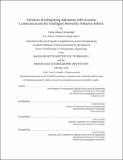| dc.contributor.advisor | Henrik Schmidt. | en_US |
| dc.contributor.author | Schneider, Toby Edwin | en_US |
| dc.contributor.other | Woods Hole Oceanographic Institution. | en_US |
| dc.date.accessioned | 2013-06-17T19:04:24Z | |
| dc.date.available | 2013-06-17T19:04:24Z | |
| dc.date.copyright | 2013 | en_US |
| dc.date.issued | 2013 | en_US |
| dc.identifier.uri | http://hdl.handle.net/1721.1/79162 | |
| dc.description | Thesis (Ph. D.)--Joint Program in Oceanography/Applied Ocean Science and Engineering (Massachusetts Institute of Technology, Dept. of Mechanical Engineering; and the Woods Hole Oceanographic Institution), 2013. | en_US |
| dc.description | This electronic version was submitted by the student author. The certified thesis is available in the Institute Archives and Special Collections. | en_US |
| dc.description | Cataloged from student-submitted PDF version of thesis. | en_US |
| dc.description | Includes bibliographical references (p. 151-161). | en_US |
| dc.description.abstract | Autonomous marine vehicles are increasingly used in clusters for an array of oceanographic tasks. The effectiveness of this collaboration is often limited by communications: throughput, latency, and ease of reconfiguration. This thesis argues that improved communication on intelligent marine robotic agents can be gained from acting on knowledge gained by improved awareness of the physical acoustic link and higher network layers by the AUV's decision making software. This thesis presents a modular acoustic networking framework, realized through a C++ library called goby-acomms, to provide collaborating underwater vehicles with an efficient short-range single-hop network. goby-acomms is comprised of four components that provide: 1) losslessly compressed encoding of short messages; 2) a set of message queues that dynamically prioritize messages based both on overall importance and time sensitivity; 3) Time Division Multiple Access (TDMA) Medium Access Control (MAC) with automatic discovery; and 4) an abstract acoustic modem driver. Building on this networking framework, two approaches that use the vehicle's "intelligence" to improve communications are presented. The first is a "non-disruptive" approach which is a novel technique for using state observers in conjunction with an entropy source encoder to enable highly compressed telemetry of autonomous underwater vehicle (AUV) position vectors. This system was analyzed on experimental data and implemented on a fielded vehicle. Using an adaptive probability distribution in combination with either of two state observer models, greater than 90% compression, relative to a 32-bit integer baseline, was achieved. The second approach is "disruptive," as it changes the vehicle's course to effect an improvement in the communications channel. A hybrid data- and model-based autonomous environmental adaptation framework is presented which allows autonomous underwater vehicles (AUVs) with acoustic sensors to follow a path which optimizes their ability to maintain connectivity with an acoustic contact for optimal sensing or communication. | en_US |
| dc.description.statementofresponsibility | by Toby Edwin Schneider. | en_US |
| dc.format.extent | 161 p. | en_US |
| dc.language.iso | eng | en_US |
| dc.publisher | Massachusetts Institute of Technology | en_US |
| dc.rights | M.I.T. theses are protected by
copyright. They may be viewed from this source for any purpose, but
reproduction or distribution in any format is prohibited without written
permission. See provided URL for inquiries about permission. | en_US |
| dc.rights.uri | http://dspace.mit.edu/handle/1721.1/7582 | en_US |
| dc.subject | Mechanical Engineering. | en_US |
| dc.subject | Joint Program in Oceanography/Applied Ocean Science and Engineering. | en_US |
| dc.subject | Woods Hole Oceanographic Institution. | en_US |
| dc.title | Advances in integrating autonomy with acoustic communications for intelligent networks of marine robots | en_US |
| dc.type | Thesis | en_US |
| dc.description.degree | Ph.D. | en_US |
| dc.contributor.department | Joint Program in Oceanography/Applied Ocean Science and Engineering | en_US |
| dc.contributor.department | Woods Hole Oceanographic Institution | en_US |
| dc.contributor.department | Massachusetts Institute of Technology. Department of Mechanical Engineering | |
| dc.identifier.oclc | 846911500 | en_US |
